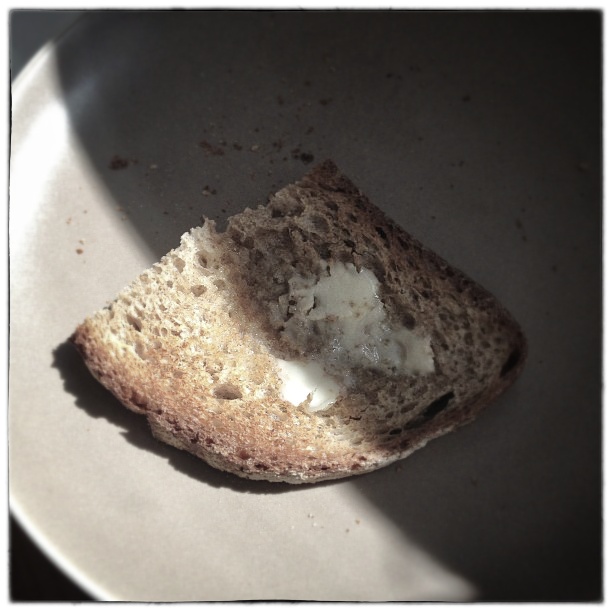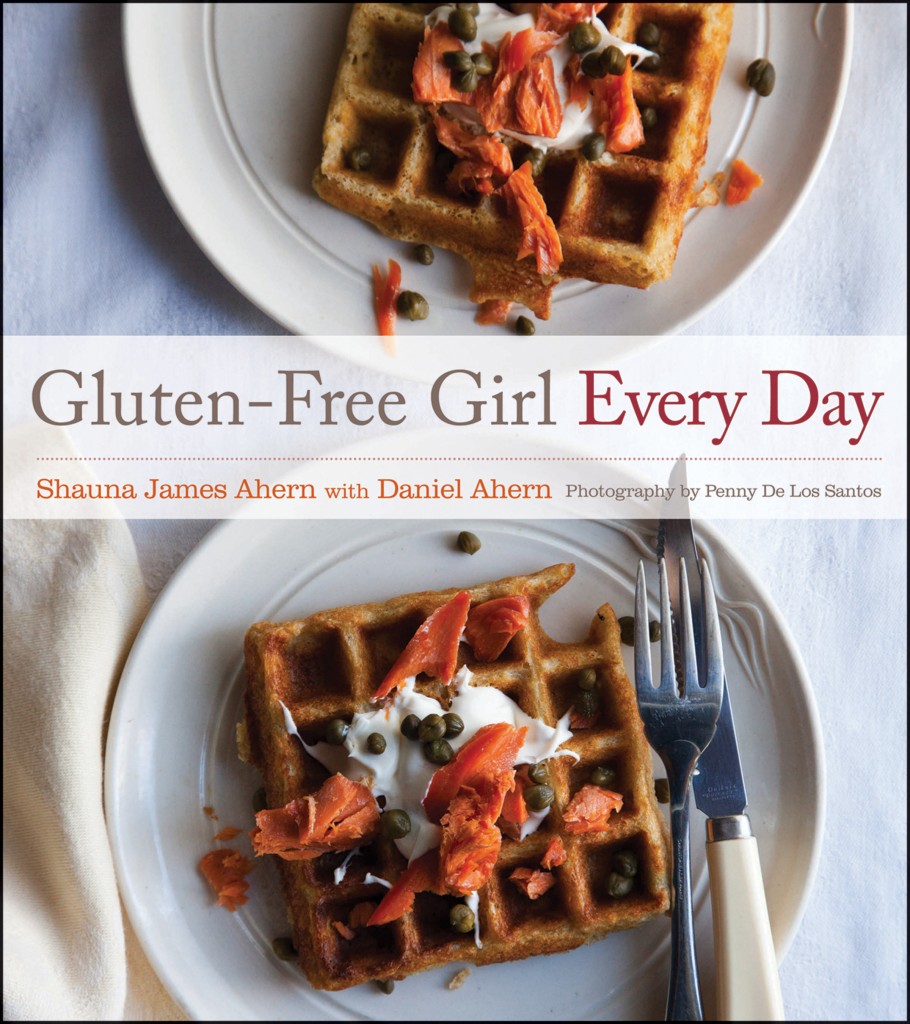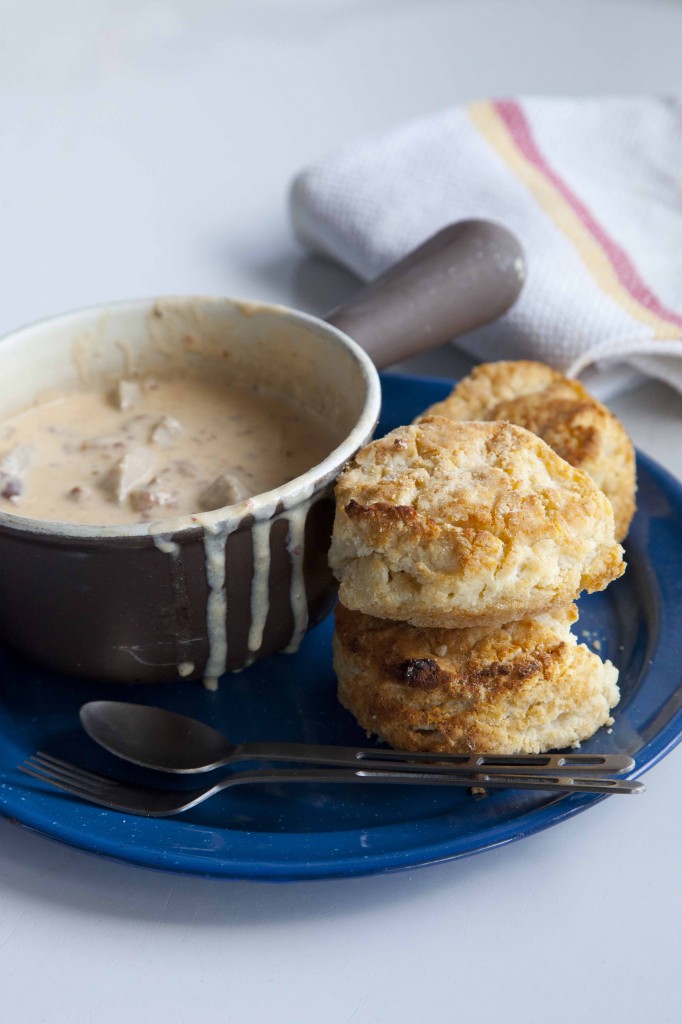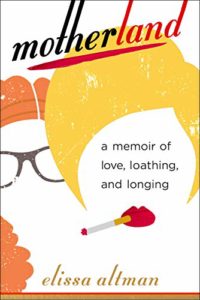“The deeper reason that breakfast inspires me is that we have become so busy maintaining our lives in the working world that we often find ourselves sharing the same house with strangers. The meaning of “home” has disappeared…Since when are business meetings, community gatherings, or basketball practice more important than talking with the people you care about and getting to know them better.”
— Marion Cunningham, The Breakfast Book, 1987
There were piles of it: great, tall rafts of yeasty, caramel-edged white bread sitting high on a Delft salad plate given to Susan by her Aunt Ethel, and particularly appropriate for a tower of toast. When I first came in to the picture, nearly fourteen years ago, breakfast was always toast and tea and coffee. Rather than buy an electric coffee maker just for my purposes, Susan purchased a tiny French press that would produce exactly one small cup of a very dark brew, which she would make while preparing her own very dark, pitch black tea, which she would share in milky spoonfuls with Macgillicuddy, her very dark, pitch black Curly Coated Retriever.
Right before we met, Susan had experimented with brioche, which was too labor intensive and felt a little bit twee. Since then, there has been an extraordinary rye loaf from one of Deborah Madison’s books, Boston brown bread steamed in an empty coffee can, Cuban white bread, Lahey’s no-knead bread (which, while delicious and simple, leaves me cold, as though the very act of kneading humanly imbues the staff with the life), and a Pullman loaf made in the pan that Deborah sent to us a few years ago, which we cherish. Over the years, as we’ve gotten busier, our breakfast bread has given way to yogurt and granola and fruit; to the infrequent poached egg sitting on a hassock of leftover French lentils; to the newspaper; to a Starbucks feta and eggwhite wrap eaten in the car while doing chores after a week at work in New York, away from the house, and each other. Eventually, we started to eat different things for breakfast — Susan might have cereal and milk, I might have smoked salmon on black bread, or leftover brown rice and a fried egg. One Christmas, I considered buying her a sterling silver English toast rack — sort of a metaphysical tether to the quiet, unifying morning meals of our earliest days — but then I realized: we didn’t eat that much bread anymore anyway.
That romance of toast was gone, replaced, we told ourselves, by more practical and clear-headed concerns surrounding carbohydrate intake and fending off metabolic syndrome, and the fact that a whole loaf for two people can go hard as a rock in a matter of a day; without the necessity of breadcrumbs to make or croutons to cut, there just didn’t seem to be much of a point to having it around.
Still, when someone recently asked me what my favorite meal was — I was in Cambridge, reading at the Harvard Bookstore on a frigid, sleeting spring night about two weeks ago — I answered without thinking: toasted bread and sweet butter.
That romance—the comfort—of having a warm, crisp slice of really great bread slathered with sweet butter in the morning at the table with the person I love is part of who I am. But exactly a week after my reading in Cambridge, it was suddenly something I could no longer eat; after one bite of a delicious buttered crust at a restaurant in Kenmore Square, my throat threatened to close up and I threatened to die.
Just like that.
It’s a sign, I told a friend, weepy and tired.
It’s an allergy, she answered, rolling her eyes.
What does it mean when the staff of life threatens to kill us? What does it mean when the most elemental thing in our lives — flour, water, yeast, salt — necessitates at the least, a Benadryl, and at the worst, an epinephrine drip?
I had been on the road for my book tour, traveling 10,000 miles to thirteen cities in less than two months. Susan was with me for some of it, but then went home from Michigan, to get back to work. Her 95 year old mother is dying of congestive heart failure and lives alone in another part of the state because she fired her caregiver, and now we’re left worrying about her, constantly. My mother lives in Manhattan and, at 110 pounds, can’t bring herself to eat a carrot stick without worrying about her weight. My stepmother is battling lymphoma and I haven’t seen her in a year. My aunt is 95 and I haven’t seen her in a year. My 106 pound Yellow Lab has Ehrlichia. I have a job I love, a 20 hour a week commute, another research-heavy book due to be delivered in late July, a novel to write, and a second food memoir beginning to percolate, about being a Jewish girl with an exigent pig problem and a simultaneous, peculiar attraction to veganism.
But this is always how it happens, I’m told. This is when your body shakes its head and refuses to accept any more stress. You max out. Your cache is full. A ball of swirling cortisol lodges in your chest just between your eighth and ninth ribs, and refuses to leave. A switch gets flipped. Your body demands attention and focus as the business of life picks at you and your time and your energy like a scab. Your immune system shuts down. You are the enemy. You attack yourself.
Your gastro-romantic anchor — warm buttered toast at breakfast — is the devil on your shoulder.
Years ago, when I was in college, when I was playing lacrosse and carrying a five course load and doing badly and secretly in love with someone off limits and my father was ill and I was playing in a coffeehouse almost every Friday evening and I was averaging five hours of sleep a night, I went through two years where everything I ate betrayed me: Bread and butter. Pasta and tomato sauce. Pizza and beer. From 1982-1984, I had a standing reservation at the Boston University health clinic, where I would show up of a lazy Sunday afternoon, and they’d pump me full of adrenaline and send me on my way. Twenty years later, while working at what might have been the worst, most prestigious job of my life — I was surrounded by sadists who took enormous pleasure in workaday torture just for the sheer enjoyment of it — I walked around breathless and in the kind of excruciating, violent pain that made my blood pressure soar and one night nearly caused me to pass out among the guinea fowl into the specialty poultry case at Whole Foods in Soho.
My food writer friends who are gluten intolerant — some are diagnosed Celiacs, some aren’t — nod when I tell them these stories; they recognize them, have lived them, and have come out the other side. Two of them initially were diagnosed after enormous systemic stress — new babies, hormone imbalances, work, chronic sleep deprivation, books due, family issues, running on empty — hit all at once. One, after a lifetime of living at a fevered pitch, sought answers for the pain her body was constantly in. These friends removed the gluten and they got better. The mere act of having to cook and think about food, and feed themselves and their families with an almost meditative focus, slowed them down. And they learned to eat again, happily. Deliciously.
This aggravates some gluten free naysayers. I have no idea why; it’s as though people with dodgy immune systems have no right to feel good, to enjoy food, or to be able to sing the glories of the mundane — the bread and butter of our lives — from every mountaintop. We turn them into pariahs because of the peace they find in the kitchen and at the table, and the joy they feel at wanting to share it despite their bodies sometimes not cooperating.
Of course, this joy also comes at a price: these gluten free people actually have had to become scientists. Rather than give up, they have had to learn to think about food in a different way: they’ve learned how to make breads and doughs from ingredients that, traditionally, can’t be made into breads and doughs. They’ve learned how to do it well, and in some cases, brilliantly. My friend Shauna Ahern is a master at it; when her new, extraordinary book falls open to the mind-boggling biscuits and gravy recipe, you can literally feel her steadfast resolve to continue to really love food, to find joy in it, and to send that message to her young daughter, and to anyone who stands still long enough for Shauna to preach to them through her words and her food, and that’s one of the things that I adore about her. Sometimes it’s been difficult for her, and sometimes it hasn’t, but she’s never, ever, ever given up hope in her message. My friend and author Erin Scott is all about the beauty and lushness of sharing fresh, gluten free food at the table; her recipes are breathtaking in their simple, remarkable elegance. And so the message among my gluten free friends and colleagues, whoever they are, is invariably the same:
Food is good. Food is home. Food is peace. Slow down. Eat. Be together. Love.
Would that we could all think that way.
So, after traveling 10,000 miles in less than two months, dealing with family crisis after crisis, worrying about my stepmom and my mom and my mom-in-law and Susan, and the two of us lately being like ships that pass in the night, and my deadlines, and my dog, and the fact that my car payment is a day late, I ate the staff of life at a restaurant in Kenmore Square and my throat closed up. A day later, a piece of German sunflower bread spread thickly with avocado and sprinkled with Maldon salt made my eyes swell shut. A day after that, I grabbed a bagel outside my office in New York, and went home sick. I’m not a celiac — I’ve experimented with sourdough bread and long-fermented pizza dough with success — but I do think my body, after so much travel and agita, has waved the white flag. It said stop, so I stopped.
I’m coming back to myself, slowly, and listening a little bit more closely to what my body is telling me: and I believe that all the stress I’ve been under — good and bad — has pitched me ass over elbow and screamed at me to slow the F down. So I’m being careful, and getting a lot of help from wonderful, smart friends like Erin and Shauna, and Shauna’s book, which is never too far away from me at any given time. Reading it and cooking from it — whether I’m probably only mildly gluten sensitive or not; the recipes are so great that one needn’t have a gluten issue to cook from it, it’s that transcendent — just makes me feel good, and joyful.
Ultimately, it was not the possibility of never having pizza again, or never being able to have a slice of garlic-rubbed, grilled country bread, or a corned beef sandwich on rye at Katz’s, that undid me when I was in the throes of my body freak-out ; it was the thought that my favorite breakfast in the world — buttered toast, stacked high and warm, eaten quietly with cups of tea and coffee and shared at home with the person I love most in the world — was just a sweet memory, how much I’ve missed it, and how very much I need it, gluten or no, especially when the world spins far too fast.
Gluten-Free Biscuits and Sausage Gravy
(Excerpted from Gluten-Free Girl Every Day, © 2013 by Shauna James Ahern and Daniel Ahern. Reproduced by permission of Houghton Mifflin Harcourt. All rights reserved.)
© Penny De Los Santos
Gluten-free Biscuits and Sausage Gravy
For years, I looked at photos of perfect biscuits—flaky, with a rise like a skyscraper made of butter and flour—and despaired. How would I ever be able to do that without gluten? My friend Nancie McDermott, a great Southern food writer, put me at ease when she told me this: “You want to know why those biscuits always turned out perfect? Because those girls had to make them every morning for years.” It’s practice that makes great biscuits, not gluten.
This recipe reads long but don’t be intimidated. I just wanted to share everything I have learned the past years so your first attempt if more successful than mine. There are only a few things you need to know: work with everything cold, don’t twirl your biscuit cutter when you cut into the dough, and have fun with this. Even misshapen, lumpy biscuits sure taste good when smothered in sausage gravy.
280 grams All-Purpose Gluten-Free Flour Mix (page 31), plus extra for dusting
1 teaspoon whole or powdered psyllium husks (page 33)
1 tablespoon baking powder
1 1⁄2 teaspoons kosher salt
8 tablespoons (1 stick) cold unsalted butter, plus more for greasing pan
3⁄4 cup buttermilk
1⁄4 cup whole milk yogurt
2 tablespoons unsalted butter, melted
Sausage Gravy (recipe follows), for serving
Combining the dry ingredients. Whisk together the flour, psyllium husks, baking powder, and salt. (I like to put them in the food processor and let it run for a few minutes to aerate the flours. You can also use a whisk and bowl.) Put the dry ingredients in a large mixing bowl. Put the bowl in the freezer.
Cutting the butter. Cut the cold butter into 1⁄2-inch cubes. Put the butter in the freezer too.
Preparing to bake. Preheat the oven to 425°F. Grease a 9-inch cast-iron pan or skillet (we use butter—you might like oil instead).
Mixing the butter and flour. When the oven is fully preheated and been at that temperature for 10 minutes, take the mixing bowl with the dry ingredients out of the freezer. Dump the butter cubes into the flour mixture. If you own a biscuit cutter, use it here to cut the butter into small chunks, roughly the same size as lima beans, as you toss them with the flour. You can also use 2 knives to serve the same purpose. My favorite technique is to use my hands. Put your hands into the flour, palms up. Pick up some butter chunks and gently massage them into the flour, pushing your thumbs forward and your fingers toward your thumbs. Do this, picking up new pieces of butter, until all the butter is the size of lima beans. (If you want fluffier biscuits than flaky, keep going until the entire bowl is filled with coarse crumbs of butter and flour.)
If you’re new at this, try the food processor. (And if you’re going to do that, put the bowl of the food processor in the freezer instead of the mixing bowl.) Put the butter cubes into the bowl of the food processor. Pulse the ingredients together, about 7 times, until the butter chunks are about the size of lima beans. Move the flour mixture to a large bowl.
Adding the liquids. Make a well in the center of the ingredients. Mix together 1⁄3 cup of the buttermilk and the yogurt in the well, then stir the liquids with a rubber spatula, moving in gentle circular motions, incorporating the flour as you go. The final dough should just hold together, with all the ingredients moist. If there is a bit of flour left on the sides of the bowl, add a dribble more of the buttermilk, then combine, then a dribble more if necessary. If the dough grows too wet, don’t fret about it. Just add a bit more flour. You’re looking for a shaggy dough, not a smooth round.
Kneading the biscuits. Sprinkle a little flour on a clean board. Turn out the dough on the board and sprinkle with just a touch more flour. Fold the dough in half, bringing the back part of the dough toward you. Pat the dough into an even round. Turn the dough 90 degrees, then fold the dough in half again and pat. This should make the dough fairly even. If not, you can fold the dough a third time. Pat out the dough to a 1 1⁄2-inch thickness.
Dip a 2 1⁄2-inch biscuit cutter into a bit of flour and push it straight down into the dough, starting from the outside edges. Do not twist the biscuit cutter. Cut out the remaining biscuits. Working quickly, pat any remaining scraps into another 1 1⁄2-inch thick dough and cut the last biscuit.
Move the biscuits to the prepared cast-iron pan, nudging them up against each other. If you nestle the biscuits alongside each other, edges touching, you will have taller biscuits after baking. (They have nowhere to go but up!)
Slide the skillet into the oven and bake the biscuits for 6 minutes. Rotate the skillet 180 degrees and continue baking until the biscuits are firm and light golden brown, about another 6 to 8 minutes. Remove the skillet from the oven and brush the tops of the biscuits with the melted butter. Let them rest for 10 minutes while you make the sausage gravy.
Feeds 4 to 6, depending on how many biscuits you want.
Sausage Gravy
1 teaspoon unsalted butter (you can also use oil, if you prefer)
1⁄2 pound sausage (try the lamb sausage on page 201)
1 1⁄2 cups whole milk (you can try nondairy milks here)
1 1⁄2 to 2 1⁄2 tablespoons sweet rice flour
Kosher salt and freshly ground black pepper
Cooking the sausage. Set a large skillet over medium heat and add the butter. When it’s foamy, add the sausage, breaking it up with the spatula so it covers the bottom of the skillet. Cook the sausage, stirring occasionally, until entirely browned, about 10 minutes. Take the sausage out of the pan and put it on a plate. You’ll need it in a moment. (If you’re in a rush, you can also leave the sausage in the skillet and make the roux around it.)
Heating the milk. Set a small pot on medium heat. Pour in the milk. Bring to a gentle simmer, then turn down the heat. Cover the milk to keep it warm.
Making the roux. Take a moment to measure the amount of fat you have left in the pan. (After you’ve made this a few times, you’ll know by sight.) You want a little more flour than fat, maybe by 1 teaspoon. So, if you have 2 tablespoons of fat, put in 21⁄2 tablespoons of sweet rice flour. And if you have more than 2 tablespoons of fat in the pan, take some out. Scatter the flour over the fat.
Whisk the flour and fat together. With gluten-free flour, you won’t make a tight ball of roux, so don’t overcook it trying to get it there. Simply stir and push the roux around the pan, cooking it to a blonde color.
Making the gravy. Pour in 1⁄2 cup of the milk. The roux will now tighten up and form a ball. Don’t worry, that’s what gluten-free roux does. Keep stirring. Add another 1/2 cup of milk and stir, breaking up the ball of roux gently. Add the rest of the milk and whisk it vigorously to break up any lumps. Turn up the heat to medium high and stir constantly until it comes to a boil. Turn down the heat to medium-low and let the gravy simmer, slowly, until it thickens, about 5 minutes.
Finishing the gravy. Add the sausage back into the gravy. Pour in 1⁄4 to 1⁄2 cup of water and stir. (If you only had a tablespoon of fat, use 1⁄4 cup.) Simmer the gravy slowly, allowing the water to blend fully with the gravy, 10 to 15 minutes. This will help to more fully cook the flour and let the taste of the sausage be the strongest. Add salt and pepper to taste. (We like a lot of pepper in our gravy.)







Beautiful Elissa. Thank you for acknowledging the tragedy of intolerance! I so, painfully get this. It is dairy for me, and something about growing a person in my already sensitive bodily vessel sends it all over-the-top. I can tell even when I eat BUTTER. Butter. Isn’t it mostly fat anyway? Good grief. Your attitude of pause and hopeful healing is inspiring though. Like there might be that “other side”. Thanks, and may it come for you again.
I love Shauna’s new book, too! It’s so open and friendly and wise. Do make her chocolate chip cookies – they are divine. Transcendent, even.
I will! Thanks Deborah!
Good lord that was so beautifully written. I wish you much health and rest!!
Thank you Elizabeth–Rest would be good…..
Beautifully written Elissa. I’m about ten years older than you, and started having wheat/gluten issues several years ago. I eat well, but still miss truly wonderful artisan breads.
Elissa, what a shame. For me, the tension manifests itself as shoulder and neck pain– so I lay down … and eat toast.
Ah, Sam, the good news though is that while I’m mildly sensitive, I’m not intolerant. I can happily eat long-fermented breads and doughs, so that’s not something that’s going away.
Oh Elissa…for me it’s sugar. But you’ve inspired me once again. To reconnect with breakfast. Berries, berries and more berries. Rest and be well. We want and need more of your genius.
I appreciate your honesty.
such a wise wise post. thank you for it. while it sound as though you have already started to do this, I just need to echo as someone who did not stop and listen to her body before irreparable damage was – LISTEN – as if there is no tomorrow and continue to learn from your body and spirit alike. good rest and good food and especially good toast to you. & susan.
Please continue to listen to your body…it has an enormous desire to heal. You have so much love in your life…I’m confident that you will find the balance you need. Your voice adds richness to my life. Thank you!
As someone who has rheumatoid arthritis, I’m familiar with the idea of the body attacking itself. Yet, I found it helpful to reframe that notion to this: our bodies aren’t attacking, they are communicating. If it’s gotten to the point they are yelling, it’s because we don’t listen to the whispers. (We are a stubborn lot!) So, I consciously love my body, and say thank you for telling me what it needs, and like you, I continue to nourish myself in many ways, including the discovery of new ways to eat. (Enjoy a piece of sourdough for me.)
I am torn, because while I don’t have a diagnosed allergy, I can feel a definite change in my body when I eat gluten. I get gassy and uncomfortable and bloated. But bread and pasta and wheat are such comfort foods! I’ve restricted them to “sometimes foods” and have the luxury of dealing through mild discomfort when I need a fix, rather than putting my overall health in danger. If I didn’t have that, I’d be pretty sad.
I need this book though, friends and some family are celiac and it’d be nice to have something to offer them when they visit 🙂
I was a Nanny when one of the kids I had in my care became gluten intolerant…we experimented but not as much as Shauna…..but we did learn that so many things are even better without heavy white flour….after a while you could taste the flour in things and preferred the alternates….we loved our chocolate chip cookies with rice flour….they spread out too far but the flavor was the best and became a family favorite for all of us! I love your stories…..love them!!!
Wonder why so many people are starting to have issues with glucose intolerance ?
Has the wheat itself been tampered with ?…GMO modification ?
It seems to be a strange phenomena, as people have been eating wheat for centuries before this showed up.
I really LIKE your blog.
thanks Rebekka!
Jody, the reason more people are being diagnosed with gluten intolerance is because it’s a condition that’s only recently been discovered, not because it didn’t previously exist. Many diseases that are around now were frequently misdiagnosed as other illnesses (or not diagnosed at all). In addition, before the internet, even if you knew you or someone you were close to was gluten-intolerant, you didn’t have access to information about others with the same condition, so it was more easily viewed as an aberration. Just because you hear more about something now doesn’t mean it hasn’t always been around or that it’s increased, it’s just a sign of how much more connected the world is now.
Elissa, thanks for the moving post and intriguing recipe. However, you didn’t include the recipe for Shauna’s All-Purpose Gluten-Free Flour mix or some other acceptable approximation. Suggestions?
Thanks for pointing that out, M. Here is a link to Shauna’s mix–http://glutenfreegirl.com/2012/07/how-to-make-a-gluten-free-all-purpose-flour-mix/
In response to Jody & M, actually the wheat is different now. It’s not GMO, but it is a hybrid called dwarf wheat that was developed in the 1960’s and has a much higher yield than prior varieties of wheat. The creator won the Nobel Peace Prize, because increased yields mean more food for the world. However, this wheat contains a different kind of gluten than ancient wheat varieties, and it’s a form that triggers inflammation/intolerance in many people. This isn’t the wheat of our ancestors.
I felt total deja vu reading this excellent post! I’m not allergic to wheat, but can feel it affecting me in times of huge stress. I once ate so much bread on a trip to Paris that I had a chronic fatigue collapse a week later, and couldn’t get out of bed for 3 weeks. I now only eat good quality breads – sourdough etc – and have to really watch my intake and vary the grains I eat. It’s so ironic, because my desert island dish is crusty white toast and salty butter, and Toast & Butter is the name of my blog – I crave the very thing that is bad for me. A nutritionist once told me that the body craves the thing it is ‘addicted’ to. How annoying eh? But a great excuse to eat good quality breads, and never the cheap white sliced…
Great posting!
Thanks Nina!
Just about 1 year ago I decided to stop eating wheat to see what affect it might have on me (other family members have food allergies.) Whoa – I felt better! Since then I have also reduced other grains in my diet and that has been beneficial too. THE hardest food to leave behind was toast with butter…my go-to profoundly comforting comfort food.
{ 2 trackbacks }